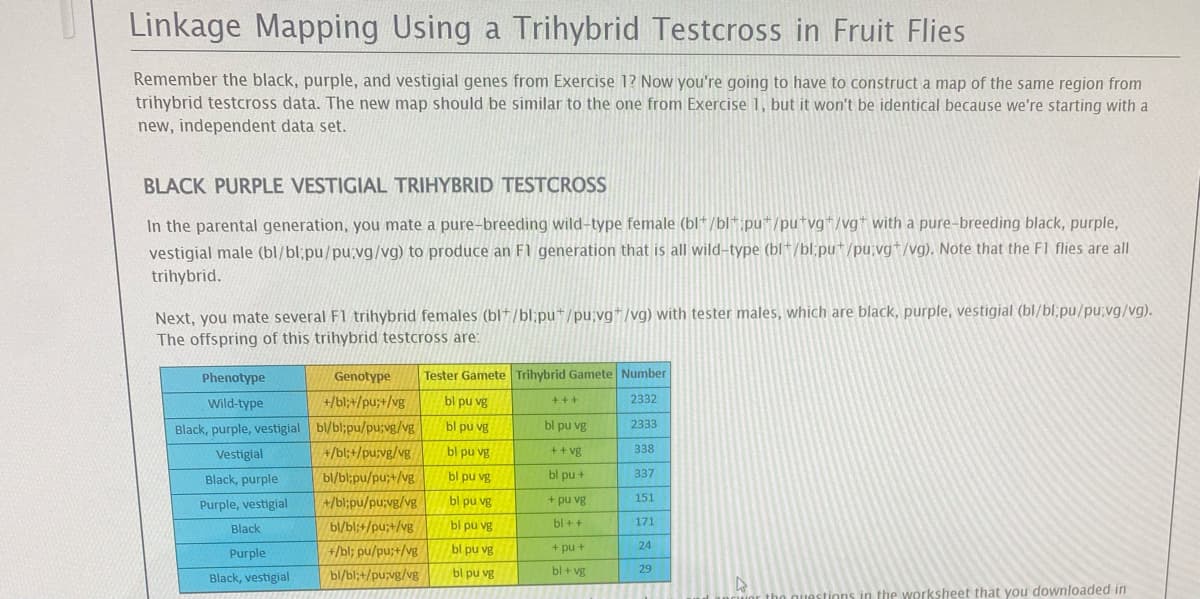Identity gene 1 (bl, pr, vg) Identity gene 2 ( bl, pr, vg) Identity gene 3 ( bl,pr, vg) How many map units separate genes 1 and 2 ( Distance 1)? How many map units separate genes 2 and 3 ( distances 2) ?
Identity gene 1 (bl, pr, vg) Identity gene 2 ( bl, pr, vg) Identity gene 3 ( bl,pr, vg) How many map units separate genes 1 and 2 ( Distance 1)? How many map units separate genes 2 and 3 ( distances 2) ?
Human Heredity: Principles and Issues (MindTap Course List)
11th Edition
ISBN:9781305251052
Author:Michael Cummings
Publisher:Michael Cummings
Chapter6: Cytogenetics: Karyotypes And Chromosome Aberrations
Section: Chapter Questions
Problem 1QP: Analyzing Karyotypes 1. Originally, karyotypic analysis relied only on size and centromere placement...
Related questions
Question
Identity gene 1 (bl, pr, vg)
Identity gene 2 ( bl, pr, vg)
Identity gene 3 ( bl,pr, vg)
How many map units separate genes 1 and 2 ( Distance 1)?
How many map units separate genes 2 and 3 ( distances 2) ?

Transcribed Image Text:Linkage Mapping Using a Trihybrid Testcross in Fruit Flies
Remember the black, purple, and vestigial genes from Exercise 1? Now you're going to have to construct a map of the same region from
trihybrid testcross data. The new map should be similar to the one from Exercise 1, but it won't be identical because we're starting with a
new, independent data set.
BLACK PURPLE VESTIGIAL TRIHYBRID TESTCROSS
In the parental generation, you mate a pure-breeding wild-type female (bl+/bl*pu*/pu+vg+/vg+ with a pure-breeding black, purple,
vestigial male (bl/bl;pu/pu vg/vg) to produce an F1 generation that is all wild-type (bl/bliput/pu;vg+/vg). Note that the F1 flies are all
trihybrid.
Next, you mate several F1 trihybrid females (bl/bl:put/pu;vg+/vg) with tester males, which are black, purple, vestigial (bl/bl;pu/pu;vg/vg).
The offspring of this trihybrid testcross are:
Phenotype
Wild-type
Black, purple, vestigial
Vestigial
Black, purple
Purple, vestigial
Black
Purple
Black, vestigial
bl pu vg
bl pu vg
Genotype Tester Gamete Trihybrid Gamete Number
+/bl;+/pu;+/vg
bl pu vg
bl/bl;pu/pu;vg/vg
+/bl;+/pu;vg/vg
bl/bl;pu/pu;+/vg
+/bl;pu/pu;vg/vg
bl/bl;+/pu;+/vg
+/bl; pu/pu;+/vg
bl/bl;+/pu;vg/vg
bl pu vg
bl pu vg
bl pu vg
bl pu vg
bl pu vg
+++
bl pu vg
+ + vg
bl pu+
+ pu vg
bl ++
+ pu +
bl + vg
2332
2333
338
337
151
171
24
29
A
the questions in the worksheet that you downloaded in
Expert Solution
This question has been solved!
Explore an expertly crafted, step-by-step solution for a thorough understanding of key concepts.
Step by step
Solved in 2 steps with 1 images

Knowledge Booster
Learn more about
Need a deep-dive on the concept behind this application? Look no further. Learn more about this topic, biology and related others by exploring similar questions and additional content below.Recommended textbooks for you

Human Heredity: Principles and Issues (MindTap Co…
Biology
ISBN:
9781305251052
Author:
Michael Cummings
Publisher:
Cengage Learning

Human Heredity: Principles and Issues (MindTap Co…
Biology
ISBN:
9781305251052
Author:
Michael Cummings
Publisher:
Cengage Learning